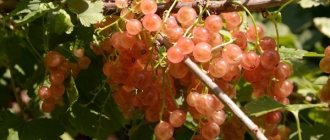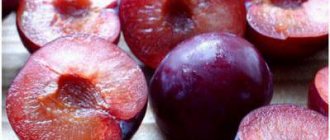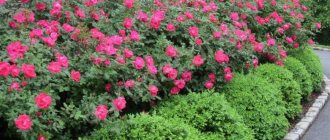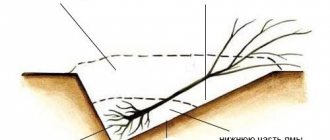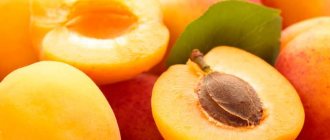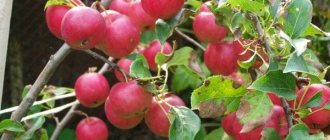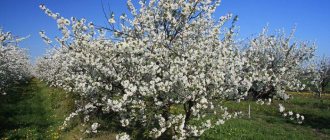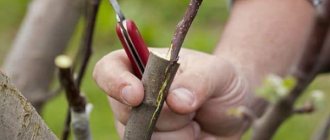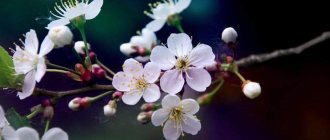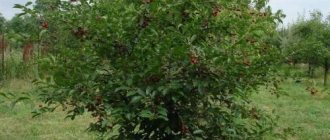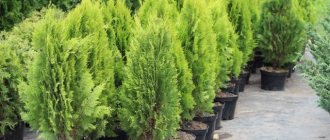Description of the Vyanok cherry
Cherry Vyanok is a new but promising variety of Belarusian selection, which has been tested in Russia since 2004. Already in the first years, it gained good popularity due to its characteristics and taste of the fruit. The cherry was obtained from the parent variety Novodvorskaya by open pollination. Employees of the Belarusian research institute worked on breeding the tree: Shirko T.S., Vyshinskaya M.I., Sulimova R.M., Syubarova E.P.
Vyanok cherry can be grown in almost any area; it develops equally well in southern and temperate climates. It withstands cold snaps, heat, and unstable winters.
Height and dimensions of an adult tree
The tree is tall, grows quickly, and is of the felt type. The crown is sparse and of medium density, has a pyramidal shape. An adult Vyanok cherry reaches a height of about 3 m.
The variety has a mixed type of fruiting. Fruits are formed both on annual growth and on bouquet branches.
Description of fruits
Cherry fruits are medium in size. Their weight reaches 3.8 g. The cherry is round in shape and has a rich dark red color. The skin is not thick, the flesh is dense, juicy. The stone is small, but easily separated. The taste of the pulp is pronounced sweet and sour. Tasting score – 4.5 points, which is not very low. The purpose of the fruit is universal. They are suitable for fresh consumption, processing and freezing.
The fruits of the Vyanok cherry are collected in clusters, it is very convenient to pick them
Vyanok cherry is highly drought-resistant; the fruits do not spoil in the sun and do not fall off. However, from excessive watering during the ripening period they can crack. That is why the amount of moisture in the soil must be carefully monitored and waterlogging must be avoided.
Pollinators of the Vyanok cherry
The Vyanok variety is characterized as self-fertile and is capable of setting fruit on its own. However, the yield will be low; for normal indicators, you still need to have pollinating trees nearby. Recommended joint cultivation with varieties:
- Lasukha;
- Novodvorskaya;
- Griot Belarusian.
Other cherries whose flowering dates coincide are also suitable. It is worth noting that Vyanok blooms early compared to other trees.
Important! This cherry is an excellent pollinator for other varieties.
Description and characteristics of Vyanok cherries
The tree is vigorous. The medium-dense crown has the shape of a raised pyramid. The type of fruiting is mixed: flower buds are formed on annual growths and bouquet branches.
The fruits are not very large, their weight is 3.7–3.8 grams. Round shape, dark red color. The stone is small, the separation from the pulp is good. The pulp is dark red, not very dense, juicy. The taste is pleasant, sweet and sour, tasters rated it 4.5 points. Sugar content - 7.82%, titratable acids - 1.1%. The juice is one-color with pulp. The fruits are used universally: fresh and for processing.
The fruits of the Vyanok cherry are medium-sized, round in shape and dark red in color.
The early fruiting rate is high; plants on the seed rootstock begin to produce crops in the third year after planting in a permanent place. The ripening period is average, consumption begins in mid-July. Productivity is high, 13 tons of fruit are harvested from one hectare when trees grafted onto wild cherry seed rootstock are placed at a distance of three meters with five-meter row spacing. Knowing the planting pattern and the volume of the harvest, it can be calculated that up to 20 kg of fruits are harvested from one tree. Plants have a stable ability to self-pollinate.
The variety is winter-hardy. Some sources note good drought resistance. Immunity to coccomycosis is average. According to the originator, there is resistance to moniliosis; in the description of VNIISPK (All-Russian Research Institute of Fruit Crop Breeding) the variety is characterized as moderately resistant to this disease.
Cherries have many benefits:
- high productivity;
- good taste;
- bone separation;
- precociousness;
- self-fertility;
- winter hardiness;
- drought resistance.
Disadvantages include tall stature and average immunity to coccomycosis and moniliosis.
In 2000–2008, in the Steppe Department of the Nikitsky Botanical Garden of the National Scientific Center of the Ukrainian Academy of Agrarian Sciences, research was carried out on almost one and a half hundred varieties of cherries, including Vyanok . Plants grafted onto Magaleb cherry rootstock were in the following growing conditions: chernozem soils in an arid climate with moderately hot summers and mild, unstable winters.
Cherry Vyanok showed:
- high productivity,
- winter hardiness,
- a small percentage of damage to flower buds during return frosts (when the temperature in April drops to -10-12°C),
- drought resistance,
- increased immunity to moniliosis.
The variety was recognized as highly adaptive and worthy of attention for its complex of economically useful traits.
Main characteristics
Many varieties of cherries are popular among Russians, but Vyanok always remains one of the few that must be planted in the garden. The fact is that the tree has many advantages and positive characteristics, its productivity is especially impressive.
Drought resistance, frost resistance
The description of the Vyanok cherry variety speaks of the tree’s high winter hardiness. It tolerates bad weather well and bears fruit well. The gardeners' photo shows that even after return frosts, the fruit buds of this variety do not freeze. That is why the plant is suitable for planting in regions with an unstable climate.
In addition, it can be noted that Vyanok cherries are excellent at resisting drought. The wood matures well and is resistant to drying winter winds and summer heat. The root system of the plant is well developed and goes deep, so it does not suffer from the vagaries of the weather.
Productivity
Special literature says that after planting in a permanent place, the Vyanok cherry begins to bear fruit only in the third year of cultivation. However, this depends on the quality of the rootstock. It has been noticed that on the seed rootstock of wild cherries, fruiting is better and begins earlier.
On average, the yield of the Vyanok variety reaches 13 t/ha, 20 kg of fruits are collected from one tree. These figures are slightly higher than those of other popular self-fertile varieties, as can be seen in the table.
| Variety name | Productivity, kg |
| Vyanok | 20 |
| Lyubskaya | 12-15 |
| Apukhtinskaya | 8-10 |
| Rossoshanskaya black | 10-15 |
High yields can be achieved through proper planting and proper care. The tree is undemanding, but simple rules must be followed.
The fruits of the Vyanok cherry are fully ripened and ready for consumption in the second half of summer. By the end of July you can enjoy delicious berries. They are used for all types of processing and fresh consumption. However, they do not last long.
Attention! Vyanok berries are of medium density, so they are not suitable for long-term transportation.
Advantages and disadvantages
Based on all the characteristics, description of the variety and reviews from gardeners, we can highlight a number of advantages of the Vyanok variety. Among them:
- high productivity;
- self-fertility;
- precociousness;
- excellent taste of fruits;
- high winter hardiness and drought resistance.
The disadvantages of this variety of cherries include average resistance to characteristic diseases, including moniliosis and coccomycosis. However, you can cope with this problem by increasing the tree’s immunity.
Vyanok cherry is characterized by high productivity
Characteristics of the variety
One of the main advantages of the Vyanok variety is its good taste. The chemical composition of its fruits is as follows:
| Quantity | Compound |
| Mass fraction of dry substances | 11,4 % |
| Titratable acids | 1,1 % |
| Sahara | 7,82 % |
| Ascorbic acid | 5.2 mg/100 g |
| Pectin | 0,47 % |
In addition, it has a very high yield of about 13 tons per hectare.
Chernaya Krupnaya, Nadezhda and Rossoshanskaya Chernaya also demonstrate high yields.
This result is achieved by a planting scheme of 5 x 3 m , using a rootstock made of wild cherry, as well as good winter hardiness , allowing the tree to easily endure prolonged negative temperatures, including quite low ones.
Due to its
self-fertility, the variety has the ability to set more than 20% of ovaries when pollinated by its own pollen.
In addition, it is an excellent pollinator for other varieties. Mayak, Novella and Pamyati Enikeev are also self-fertile.
Helpful advice: The future cherry harvest largely depends on the correct collection of berries. If you tear them off in bunches, you can damage the bouquet branch, the condition of which determines the subsequent fruiting of the tree.
Among the positive qualities of the Vyanok variety, it is also worth noting its resistance to diseases and pests. This cherry is slightly sensitive to coccomycosis and moniliosis. It is distinguished by its simplicity and unpretentiousness in agricultural technology.
Zhivitsa, Tsarevna Voylochnaya and Morozovka also demonstrate unpretentiousness in cultivation.
Landing rules
Growing Vyanok cherries is no more difficult than other popular species. It is enough to follow simple planting rules and take good care of the tree.
Recommended timing
Seedlings for planting should be selected in the fall, when nurseries have a large assortment of trees. It is not advisable to purchase cherries in the spring, since the trees may already awaken from hibernation, and planting such a plant is dangerous. It will take root poorly and hurt for a long time. It is better to start planting in early spring. The appropriate time is chosen before the sap begins to flow and the buds swell. The timing is different in each region, so it is better to navigate the weather, local climate and other trees.
The main task of the gardener is to properly preserve the seedling until planting. To do this, you can dig it in the garden or lower it into a cold cellar.
Site selection and soil preparation
For better fruiting, plant cherries on the southern slope of the site. If this is not possible, then a well-lit place on the west side will do. However, it must be protected from cold winds and drafts.
The soil for planting is prepared in advance. It should allow moisture and air to pass through well. To do this, dig up the place, adding humus, sand and mineral fertilizers. It is believed that stable fruiting is possible on neutral soil. If it is too acidic, then add slaked lime or chalk.
Warning! The groundwater level for planting Vyanok cherries should be no higher than 2 m.
The description of the Vyanok variety states that the tree’s root system does not tolerate close proximity to groundwater. This is why wetlands and damp places are not suitable for planting.
How to plant correctly
Vyanok cherries are planted according to a scheme designed for vigorous trees. In an amateur garden, they maintain a distance of 3 m between them. If the plantings are done in a row, then they retreat up to 4 m.
Tree holes are prepared in the fall so that by spring the soil is well settled and saturated with fertilizers. Before planting, the bottom is drained. You can use available materials, such as broken bricks, crushed stone or tiles. The seedlings are placed in the center of the hole, covered with soil, but the root collar is left on the surface of the soil, 5 cm.
During planting, the grafting site is not covered with earth so that it does not begin to rot.
Early ripening cherry varieties
ZHYVITSA
The tree is medium-sized, the crown is round, of medium density, raised.
Biological features: Self-sterile. The best pollinators are Seedling No. 1, Novodvorskaya, Vyanok, and cherry varieties.
The fruits are medium size (3.7 g), round in shape, dark red. The stone is small and easily separated from the pulp.
The pulp is dark red, medium density, juicy, with a pleasant sweet and sour taste (tasting score - 4.8 points). The juice is dark red.
Consumption period: end of June – beginning of July.
Advantage: The variety is winter-hardy, productive, resistant to coccomycosis, and not affected by monilial burn.
ZARANKA
The tree is medium-sized, with a pyramidal, raised crown of medium density.
Biological features: Partially self-fertile. The best pollinators are Pamyati Vavilov, Seedling No. 1, Novodvorskaya, Vyanok, cherry varieties Narodnaya, Zhurba, Syubarovskaya.
The fruits are medium size (4.5 g), round in shape, dark red. The stone is medium-sized and easily separated from the pulp.
The pulp is dark red, medium density, juicy, with a pleasant sweet and sour taste (tasting score - 4.7 points). The juice is dark red.
Consumption period: early July.
Advantage: The variety is winter-hardy, productive, and moderately resistant to coccomycosis and monilial blight.
Cherry varieties. LASUHA
A tree of medium vigor, with a spherical, raised crown of medium density.
Biological features: Self-sterile. The best pollinators are Vyanok, Novodvorskaya, North Star.
The fruits are large (4.8 g), round, dark red. The stone is small and easily separated from the pulp.
The pulp is dark red, medium density, juicy, with a pleasant sour-sweet taste (tasting score - 4.8 points). The juice is dark red.
Consumption period: first to second ten days of July.
Advantage: The variety is winter-hardy, productive, resistant to coccomycosis, and not affected by monilial burn.
IN MEMORY OF VAVILOV
The tree is vigorous, with a wide-pyramidal, raised crown of medium density.
Biological features: Partially self-fertile. The best pollinators are Novodvorskaya, Vyanok, Seedling No. 1.
The fruits are medium-sized (average weight - 4.2 g), wide-heart-shaped, dark red. The stone is medium-sized and easily separated from the pulp.
The pulp is dark red, juicy, sweet and sour taste (tasting score - 4.7 points). The juice is dark red.
Consumption period: first ten days of July.
Advantage: The variety is winter-hardy, productive, resistant to coccomycosis, and moderately affected by monilial burn.
Cherry varieties. SEEDLING No. 1
A tree of medium vigor, with a rounded, raised crown of medium density.
Biological features: Self-fertile.
The fruits are medium in size (average weight - 3.9 g), flat-round in shape, light red. The stone is small and easily separated from the pulp.
The pulp is light yellow, juicy, sweet and sour taste (tasting score - 4.7 points). The juice is slightly colored.
Consumption period: end of June – beginning of July.
Advantage: The variety is winter-hardy, productive (up to 22 t/ha), moderately resistant to coccomycosis and monilial burn.
Features of care
Vyanok cherries do not require special care. Even a busy gardener who rarely visits the site will be able to grow and harvest a decent harvest. To do this, it is enough to follow the recommendations given in the description of the variety.
Watering and fertilizing schedule
As already mentioned, Vyanok cherries are drought-resistant, so additional watering is not required. The soil is moistened when there has been no rain for a very long time. During the season, it is enough to water the tree generously several times. However, the procedure must be complete so that the moisture saturates the earthen ball to the entire depth of the roots. In order not to over-moisten the soil, it is better to adhere to the following watering scheme:
- after the formation of the ovary;
- during fruit filling;
- during the period of fruit bud formation the next day.
The rest of the time, there is no need to moisten the soil to prevent water stagnation at the roots. This causes more harm than drought.
Advice! If the weather is rainy, then there is no need to water the Vyanok cherry. Natural moisture will be enough.
To increase productivity, Vyanok are fed like all crops. Stick to the standard scheme. In early spring, nitrogen is added to the soil, and in summer and autumn, phosphorus-potassium fertilizers are applied. Liquid organic mixtures are effective. Chicken manure and cow manure are popular among gardeners. It is better to apply dry organic fertilizers in the fall, combining them with digging around the tree trunk.
Trimming
The crown of a tall tree must be shaped to prevent fungal diseases. For cherries, it is better to stick to a tierless formation. The seedling is cut at a height of 30-40 cm, and the next four years continue to form it. To do this, leave 8-12 skeletal branches, which are directed in different directions. All excess is cut out. The distance between the skeletal branches is left 10-15 cm. Subsequently, all side shoots are shortened to stimulate fruiting.
Pruning is combined with cleaning the tree. Dry, damaged and diseased branches are regularly cut out.
Preparing for winter
In late autumn, cherries need to be prepared for the coming winter. It is better to protect young seedlings from frost. To do this, the trunk is wrapped in burlap to the base of the skeletal branches. Mature trees do not need additional shelter.
In regions with dry and windy winters, moisture-charging irrigation is carried out in late autumn so that the roots of the tree are saturated with moisture and do not dry out. It is made before the upcoming frost. The tree is watered abundantly so that moisture penetrates the entire depth of the root system.
Diseases and pests
The description of the variety states that the crop is susceptible to characteristic diseases. There are frequent cases of outbreaks of moniliosis and coccomycosis. To avoid damage, you should not neglect preventive work. Without them, not only the tree, but also the crop will suffer.
Treatments with Bordeaux mixture are effective against fungal diseases. They are done on a schedule in spring and autumn. Other preparations containing copper and insecticides against pests can be added to the solutions. In summer, Bordeaux mixture is not used. It is better to replace it with the drugs “Horus”, “Skor” and others.
